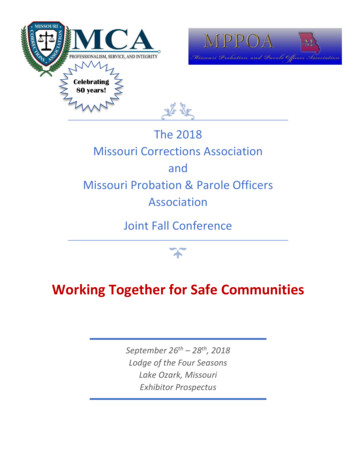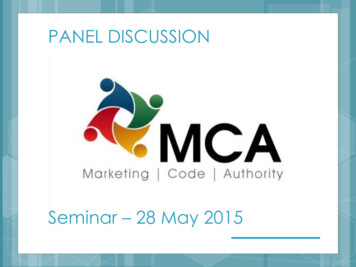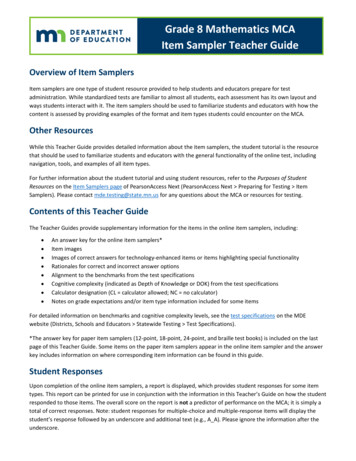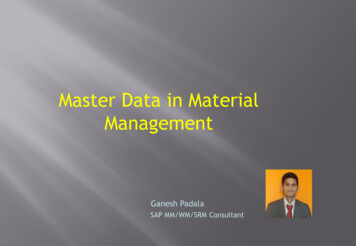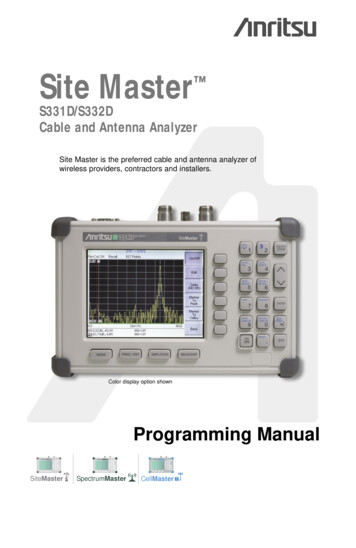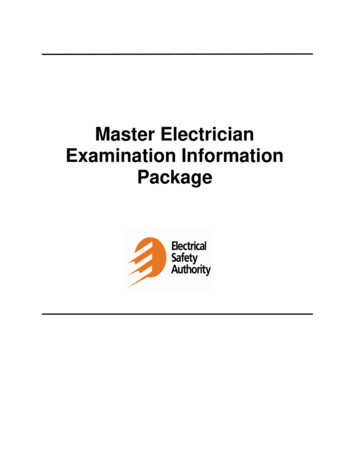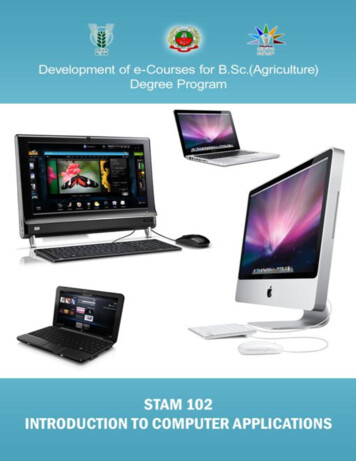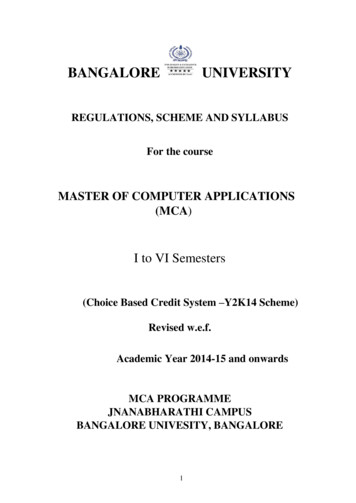
Transcription
BANGALOREUNIVERSITYREGULATIONS, SCHEME AND SYLLABUSFor the courseMASTER OF COMPUTER APPLICATIONS(MCA)I to VI Semesters(Choice Based Credit System –Y2K14 Scheme)Revised w.e.f.Academic Year 2014-15 and onwardsMCA PROGRAMMEJNANABHARATHI CAMPUSBANGALORE UNIVESITY, BANGALORE1
BANGALORE UNIVERSITYRegulations of Master of Computer applications (MCA) Course1TITLE OF THE COURSE: The course shall be called MCA – Master ofComputer Applications.2DURATION OF THE COURSE: The course of study shall be three years.3ELIGIBILITY FOR ADMISSION: A candidate with any degree of a minimumof 3 years duration (10 2 3) of Bangalore university or of any other Universityequivalent there in to with a minimum of 50% of marks in the aggregate of allsubjects including languages, if any, provided further, that the candidate hasstudied mathematics / Computer science /Business Mathematics / Statistics /Computer Applications / Electronics as a subject at PUC level or equivalent HSC(XII Standard) or at Degree level is eligible for admission to MCA Course.Relaxation to SC/ST, Group I be extended as per University norms.4ATTENDANCE: In each Semester a candidate should be considered to havesuccessfully undergone the prescribed Course of study if the candidate hasattended at least 75% of the classes in each subject (Theory, Lab & Practical).5SCHEME OF EXAMINATION:A The Internal Assessment marks should be decided for each of the theory subjectsby conducting 2 tests, each of 60 minutes duration, spread over the span of aSemester. A seminar should also be given by the student in the third year and thesame to be assessed and evaluated for internal assessment along with the twotests.B The Internal Assessment marks in Practical course is based on the performance inthe Laboratory. The Internal Assessment marks for Project work of a candidate isbased on the dissertation Seminar.6ELIGIBILITY TO GO TO THE HIGHER SEMESTER:A A Candidate is allowed to carry over all the previous uncleared (failed) theorypapers and Practicals to subsequent semesters from the first to sixth semester.B The maximum period for completion of the course shall be six years from thedate of admission.7MINIMUM FOR PASS AND DECLARATION OF RESULTSA For a pass in a semester, a candidate shall secure a minimum of 40% ofthe marks prescribed for a subject in the University Examination (Theory,Practical, Project work) and 50% of the marks in the aggregate inclusiveof the Internal Assessment marks obtained in all subjects put together.B The candidates who do not satisfy 7(a) shall be deemed to have failed andhave to take exams in the subjects in which he has secured less than 40%at the University examination.2
C Provision is made for rejection of results of all the subjects of a Semesteronly once, if the candidate decides to reappear for all the subjects of thatsemester. Such rejection should be made within 30 days of announcementof result, by making a written application, through the Head of theInstitution. If such rejection is in respect of the results of all the subjects ofone semester and earn fresh Internal marks as well.D The results of any semester will be declared as pass or fail as the case maybe in accordance with regulation 7(a).E To be eligible for the award of the MCA degree, a candidate shall havecompleted the scheme of training and passed in all subjects prescribed forthe CourseF Further to regulation 7(a), the classification followed by the University forall PG courses shall be made applicable for the declaration of results ofeach Semester.8CLASSIFICATION OF RESULT FOR THE MCA COURSE ANDDECLARATION OF RANKS:Further to regulations 7(a) and 7(f), the names of all successful candidatessecuring First Class with Distinction and First Class in the First attempt shallbe arranged in the order of Merit and only first FIVE Ranks shall be declared.9A candidate shall complete examinations of all Semesters of MCA Course within- SIX years from the date of admission3
SCHEME OF STUDY AND EXAMINATION FOR MASTER OFCOMPUTER APPLICATIONS (MCA)SemPaper 04C Programming Lab830701004MCA106PAccounting Lab830701004MCA201TData se ManagementSystemComputer NetworksMCA204TOperating System430701004MCA205PData Structures Lab830701004MCA206PDBMS Lab830701004MCA301TFile Structures430701004430701004430701004MCA303TObject Oriented Analysisand Design using UMLTheory of ComputationMCA304TStatistical Analysis430701004MCA305PFile Structures 02TIIIIAMCA104TMCA102TIICreditsProblem SolvingTechniques using CAccountingandFinancial ManagementDigital Electronics andMicroprocessorDiscrete MathematicsMCA101TITitle of the paperMarksHours /WeekMCA402TMCA403TMCA404TObject Oriented Analysisand Design using UMLLabSoft Core – Quantitative,Teaching and ResearchAptitudeAdvanced JavaProgrammingAdvanced AlgorithmsAdvanced SoftwareEngineeringQuantitative TechniquesSem242426264307010044307010044
MCA503TAdvanced JavaProgramming LabAdvancedAlgorithmsLabSoft Core – Soft SkillsandPersonalityDevelopmentAdvanced WebProgrammingAdvanced DatabaseManagement SystemsArtificial IntelligenceMCA504TOpen 701004830701004830701004MCA506PAdvanced WebProgramming LabMini ProjectMCA601TElective – I430701004MCA602TElective – II430701004MCA603PMain Project161502504008MCA505PVI8Students have to choose any two Electives from the given list in the Sixthsemester.1. Software Testing2. e-Governance3. Data Mining4. Big Data Analytics5. Cloud Computing6. Parallel Algorithms7. Image processing8. Mobile Computing9. Compiler Design10. TCP / IP11. Storage Area Network12. Multimedia Communication13. Distributed Operating Systems52416
FIRST SEMESTER MCAMCA101T: PROBLEM SOLVING TECHNIQUES USING CTotal Teaching Hours: 52No. of Hours / Week: 04UNIT - I[12 Hours]Introduction to Programming Concepts: Software, Classification of Software, ModularProgramming, Structured Programming, Algorithms and Flowcharts, Writing algorithmsand drawing flowcharts for simple exercises. Overview of C Language: History of C,Character set, C tokens, Identifiers, Keywords, structure of C program, executing a Cprogram. Constants, variables, data types, declaration of variables, declaration of storageclasses, assigning values to variables defining symbolic constants, declaring a variable asconstant, declaring a variable as volatile, overflow and underflow of data, Operators in C,Hierarchy of Operators, Expressions, Type Conversions and Library Functions.UNIT – II[10 Hours]Managing Input and Output Operations: The scanf() & printf() functions for input andoutput operations, reading a character, writing a character, (the getchar() & putchar()functions) , the address operator(&), formatted input and output using format specifiers,Writing simple complete C programs. Control Statements: Decision making with ifstatement, simple if statement, the if else statement, nesting of if else statements, the elseIf ladder, the switch statement, the?: operator, the goto statement, the break statement,programming examples. Loop Control Structures: The while statement, the do Whilestatement, the for statement, nested loops, jumps in loops, the continue statement,programming examples.UNIT – III[10 Hours]Functions: Function Definition, prototyping, types of functions, passing arguments tofunctions, Nested Functions, Recursive functions. Arrays: Declaring and Initializing, OneDimensional Arrays, Two Dimensional Arrays, Multi Dimensional Arrays - Passingarrays to functions. Strings: Declaring and Initializing strings, Operations on strings,Arrays of strings, passing strings to functions. Storage Classes - Automatic, External,Static and Register Variables.UNIT – IV[10 Hours]Structures and Unions: Defining a structure, declaring structure variables, accessingstructure members, structure initialization, copying and comparing structure variables,operations on individual members, array of structures, structures within structures,structures and functions, Unions, size of structures, bit fields, programming examples.Pointers: Understanding pointers, accessing the address space of a variable, declaring andinitialization pointer variables, accessing a variable through its pointer, chain of pointers,pointer expressions, pointers and arrays, pointer and character strings, array of pointers,pointer as function arguments, functions returning pointers, pointers to functions, pointersand structures, programming examples6
UNIT – V[10 Hours]File Management in C: Defining and opening a file, closing a file, input/output operationson files, error handling during I/O operations, random access files, command linearguments, programming examples. Dynamic Memory Allocation: Dynamic memoryallocation, allocating a block of memory: malloc, allocating multiple blocks of memory:calloc, releasing the used space: Free, altering the size of a block: realloc, programmingexamples. The Preprocessor: Introduction, macro substitution, files inclusion, compilercontrol directives, ANSI additions, programming exercises.Reference1. E. Balaguruswamy, “Programming in ANSI C”, 4th Edition, TMH Publications,2007.2. Ashok N. Kamthane, “Programming with ANSI and Turbo C”, Pearson Education,2006.3. Mahapatra, “ Thinking In C ”, PHI Publications, 1998.4. Yashwant Kanetkar, “Let Us C”, 13th Edition, PHP, 2013.7
MCA102T: ACCOUNTING AND FINANCIAL MANGEMENTTotal Teaching Hours: 52No. of Hours / Week: 04UNIT - I[12 Hours]Accounting: Principles, concepts and conventions, double entry system of accounting,Introduction to basic books of accounts of sole proprietary concern, closing of books ofaccounts and preparation of trial balance. Final Accounts: Trading, Profit and Lossaccounts and Balance Sheet of sole proprietary concern (Without adjustments).UNIT - II[10 Hours]Company accounts: features of company, types of companies advantages of companies,types of shares and debentures. Preparation of Final accounts of companies. (simpleproblems only).UNIT - III[10 Hours]Financial Management: Meaning, scope and role, A brief study of functional areas offinancial management. Introduction to Various FM Tools: Financial statement analysis.Common size and comparative statement analysis of income and balance sheetsUNIT - IVRatio Analysis, Fund flow statement & Cash flow statement.[10 Hours]UNIT - V[10 Hours]Introduction to Cost Accounting: Nature, Importance & Basic Principles. BriefIntroduction to methods of Costing & Elements of Cost, Unit Costing.Reference1. Ramachandran, “Financial Accounting for Managers”, Tata McGraw Hill –20052. I.M. Pandey, “Financial Management”, Vikas Publications, 20033. Neeraj Sharma “Computerized Accounting & Business Systems”, KalyaniPublishers, 20044. V.R Palanivelu “ Accounting for Management” University Science Press 2013.8
MCA103T: DIGITAL ELECTRONICS AND MICROPROCESSORTotal Teaching Hours: 52No. of Hours / Week: 04UNIT – I[12 Hours]Introduction to Number Systems: Positional and non-positional, Base/ Radix. Decimalnumber system, Binary number system, Octal Number System and Hexadecimal NumberSystem, Conversion from one System to another System. Binary addition, subtraction,multiplication and division. 1’s and 2’s complement – 2’s complement subtraction.Binary codes: BCD numbers, 8421 code, 2421 code- examples and applications. Graycode- Conversions- Gray to binary and Binary to Gray, application of gray code. Excess– 3 code - Self complementing property and applications. Boolean algebra: - Laws andTheorems. AND, OR, NOT Laws, Commutative law, Associative law, Distributive law,Duality theorem. Demorgan’s theorems – Statements, proof using truth tables;Simplification of Boolean expressions using Boolean laws. Definition of product term,sum term, min term ,max term, SOP, standard SOP, POS and Standard POS. Conversionof Boolean expression to Standard SOP and Standard POS forms.UNIT – II[10 Hours]Karnaugh maps- Definition of Karnaugh map, K- map for 2, 3 and 4 variables.Conversion of truth tables into k-map, grouping of cells, redundant groups and don’t careconditions. Karnaugh map technique to solve 3 variable and 4 variable expressions.Simplification of 3 and 4 variable Boolean expression using K-maps. AND Gate, ORGate, NOT Gate, NAND Gate and NOR Gate - Definition, Symbol, Expression, TruthTable. Combinational logic circuits: Definition, applications. Half Adder: Symbol, Logiccircuits using XOR and basic gates, Truth table. Full Adder: Symbol, Logic circuits usingXOR and basic gates, Truth table.UNIT – III[10 Hours]Sequential circuit design: Latches, SR Flip Flops, concept of edge triggering, D- flipflop, JK- flip flop, Master slave flip flop, T- flipflop, Registers, shift Registers,asynchronous and synchronous counters, Mod10 – counter. Introduction toMicroprocessor: Introduction, Applications, Basic block diagram, speed, word size,memory capacity, classification of Microprocessors (mention of differentmicroprocessors). 8086Architecture and programming: 8086 Architecture andprogramming model, registers, flags, memory segmentation, pin description, odd & evenbank of memory, Bus buffering, latching, timing diagrams, wait state, MIN/MAX modesof operation.UNIT – IV[10 Hours]Addressing modes: Immediate addressing, register addressing, memory addressing,indexed addressing with displacement, I/O port addressing. 8086 Instructions: Instructiontemplate for 8086 instructions, code generation using template. Data Transfer Instruction:Move date to register/memory from register/memory/immediate data, data transferbetween a segment register and register/memory, PUSH and POP, exchange, data transferwith I/O ports.9
UNIT – V[10 Hours]Data Conversion instructions: XLAT, LEA, LDS, LES, LAHF and SAHF instructions.Arithmetic Instructions: Add, subtract, negate, compare, CBW, CWD, multiply anddivide instructions. Logical Instructions: AND, OR, EX-OR, Test, NOT, ROTATE andshift instructions. Process Control Instructions: Instructions to set/reset flags, halt, wait,lock, prefix and escape to co-processor instructions. String Instructions: CMPS, MOVS,LODS, STOS, and SCAS instructions. Branch Instructions: JMP, conditional jump,LOOP, LOOPE, LOOPNE, JCXZ, CALL, RET. Assembly language programming:Assembly language programming examples, subroutines and macros, examples.Interrupts of 8086: Hardware interrupt, software interrupt and exception, priority ofinterruptsReference1. Thomas L Floyd, “Digital Fundamentals”, Pearson Prentice Hall, 9th Edition,2006.2. M Morris Mano, “Digital Logic and Computer Design, Pearson, 10th Edition,2008.3. Tokheim, “Digital Electronics Principles and Applications, McGraw Hill,6th Edition, 2004.4. Barry B. Brey, “The Intel Microprocessors”, Pearson Prentice Hall, 8th Edition,2009.5. Ramesh S. Gaonkar, “Microprocessor Architecture, programming andApplications”, New Age International Pvt Ltd Publishers, 2nd Edition, 1995.10
MCA104T: DISCRETE MATHEMATICSTotal Teaching Hours: 52No. of Hours / Week: 04UNIT – I[12 Hours]Set Theory: Sets and Subsets, Set Operations and the Laws of Set Theory, Counting andVenn Diagrams, Cartesian Products and Relations, Functions–One-to-One, OntoFunctions, Function Composition and Inverse Functions; Properties of Relations,Computer Recognition – Zero-One Matrices and Directed Graphs, Partial Orders – HasseDiagrams, Equivalence Relations and Partitions.UNIT – II[10 Hours]Fundamentals of Logic: Proposition, Logical Connectives and Truth Tables, LogicEquivalence – The Laws of Logic, Logical Implication – Rules of Inference; The Use ofQuantifiers, Quantifiers, Definitions and the Proofs of TheoremsUNIT – III[10 Hours]Mathematical Induction and Recursion: Sequences and summations, MathematicalInduction, The Well Ordering Principle, Recursive Definitions, Structural Induction,Recursive algorithms. Counting: Basics of counting, Pigeonhole Principle, Permutationand Combinations, Binomial coefficients.UNIT – IV[10 Hours]Discrete Probability: Introduction, Probability Theory, Expected value and Variance.Advanced Counting Techniques: Recurrence relations and its solutions, Generatingfunctions, Inclusion – Exclusion and its applications Relations: Introduction, n-aryrelations and applications, Representing relations, Closures of Relations, EquivalenceRelations, Partial OrderingsUNIT – V[10 Hours]Graphs: Introduction, Representing Graphs & Graph Isomorphism, Connectivity, Eulerand Hamilton Paths, Shortest path problems, Planar Graphs, Graph colouring. Trees:Introduction, Applications of Trees, Tree Traversal, Spanning Trees, Minimum SpanningTrees.Reference1. Ralph P. Grimaldi, “Discrete and Combinatorial Mathematics”, 5th Edition,Pearson Education, 2004.2. Kenneth H. Rosen, “Discrete Mathematics and its Applications”, 6th Edition,McGraw Hill, 2007.3. Jayant Ganguly, “A Treatise on Discrete Mathematical Structures”,SanguinePearson, 2010.4. D.S. Malik and M.K. Sen, “Discrete Mathematical Structures: Theory andApplications”, Thomson, 2004.5. Thomas Koshy, “Discrete Mathematics with Applications”, Elsevier, 2005,Reprint 2008.11
MCA105P: PROBLEM SOLVING TECHNIQUES USING C LAB1. Write a C Program to demonstrate all the operators.2. Write a C Program for electricity bill tacking different Categories of users,different slabs in each category.3. Write a C Program to find check whether the given number is Prime or not.4. Write a menu driven C Program to find the factorial of number (a) Withoutfunction (b) Using non-recursive function (c) Using Recursive Function.5. Write a C Program to check the correctness of the date and compare two dates.6. Write a C Program to find the sum of its individual digits repeatedly till the resultis a single digit.7. Write a program to enter integer number and find the largest and smallest digit ofthe number.8. Write a program to read three digits ve integer number ‘n’ and generate possiblepermutations of number using their digits.9. Write a C Program to accept a text upto 50 words and perform following actionsa) Count total vowels, constants, spaces, sentences and words with spaces.b) Program should erase more than one space between two successive words.10. Write a C program to enter names of cities and display all the entered namesalphabetically.11. Write menu Driven C Program to calculate to calculate sin, cos and exponentialseries without using standard library function.12. Write a C Program to accept array of elements in unsorted order, sort the arrayand search an element using binary search.13. Write a C Program to add and multiply two matrices.14. Write a C Program to display list of C program files and directories.15. Write a program to use macros as an array and pointer.16. Write a program to display the attributes of a file using dos interrupt.17. Write a program to delete a file using dos interrupt.18. Create user defined data type equivalent to int. Declare three variables of its type.Perform arithmetic operations using these variables.19. Write a program to read a C program file and count the following in the completeprogram. a) Total number of statementsb) Total number of included filesc) Total number of brackets.20. Write a program to display C Program files in current directory. The user shouldselect one of the files. Convert the file contents in Capital and Display the sameon the screen.21. Write a program to interchange the contents of two files.22. Write a program to change mouse cursor.12
MCA106P: ACCOUNTING AND FINANCIAL MANAGEMENT LAB1. Accounting software, introduction and installation.2. Creation of accounts in the name of the trading and non-trading organisations,including alteration and deletion.3. Creation of accounting groups and ledgers, using single and multiple options.4. Creation of inventory groups and ledgers.5. Vouchers, types and vouchers entry.6. Creation of various accounting Ledgers.7. Recording of various accounting transactions.8. Inventory: classification and grouping using single and Multiple options.9. Recording of inventory information.10. Purchase order and sales order processing.11. Correction of ledgers and vouchers using alter option.12. Generating trial balance, income statement and balance sheet.13. Displaying Income statement and balance sheet under different options and timeperiods.14. Generation of accounting and inventory reports.15. Printing of ledgers, invoice, cheques and statements.16. Creation of pay roll records.17. Recording of Pay roll information and salary statement.18. Generating statutory reports.19. Working with different accounting periods.20. File import and export process.21. Data protection and safeguard.22. Practical training on preparation of computerised accounting for computer hardwarestores.23. Practical training on preparation of computerised accounting for a softwaredevelopment company.24. Training on conversion of Manual accounting to computerised accounting.25. Practical session on audit under computerised accounting environment.26. Practical session on audit under computerised accounting environment.13
SECOND SEMESTER MCAMCA201T: DATA STRUCTURESTotal Teaching Hours: 52No. of Hours / Week: 04UNIT – I[12 Hours]Introduction and Overview: Definition, Elementary data organization, Data Structures,data structures operations, Abstract data types, algorithms complexity, time-spacetradeoff. Preliminaries: Mathematical notations and functions, Algorithmic notations,control structures, Complexity of algorithms, asymptotic notations for complexity ofalgorithms. String Processing: Definition, Storing Stings, String as ADT, Stringoperations, word/text processing, Pattern Matching algorithms.UNIT – II[10 Hours]Arrays: Definition, Linear arrays, arrays as ADT, Representation of Linear Arrays inMemory, Traversing Linear arrays, Inserting and deleting, Sorting: Bubble sort, Insertionsort, Selection sort, Merge Sort, Quick Sort Searching: Linear Search, Binary search,Multidimensional arrays, Matrices and Sparse matrices.UNIT - III[10 Hours]Linked list: Definition, Representation of Singly linked list in memory, Traversing aSingly linked list, Searching a Singly linked list, Memory allocation, Garbage collection,Insertion into a singly linked list, Deletion from a singly liked list; Doubly liked list,Header liked list, Circular linked list.UNIT – IV[10 Hours]Stacks: Definition, Array representation of stacks, Linked representation of stacks, Stackas ADT, Arithmetic Expressions: Polish Notation, Conversion of infix expression topostfix expression, Evaluation of Postfix expression, Application of Stacks, Recursion,Towers of Hanoi, Implementation of recursive procedures by stack. Queues: Definition,Array representation of queue, Linked list representation of queues Types of queue:Simple queue, Circular queue, Double ended queue, Priority queue, Operations onQueues, Applications of queues.UNIT - V[10 Hours]Graphs: Graph theory terminology, Sequential representation of Graphs: Adjacencymatrix, traversing a Graph. Tree – Definitions, Binary trees, Representing binary trees inmemory, Traversing Binary Trees, Binary Search Trees, Searching, Inserting andDeleting in a Binary Search Tree, Heap, Heap Sort.Reference1. Seymour Lipschutz, “Data Structures with C”, Schaum’s outLines, TataMcGrawHill, 2011.2. Mark Allen Weiss, “Data Structures and Algorithm Analysis in C”, SecondEdition, Pearson Education, 2013.3. Robert Kruse, C.L.Tondo, Bruce Leung, Shashi Mogalla, “Data Structures andProgram Design using C”, Pearson Education, 2009.4. Forouzan, “A Structured Programming Approach using C”, 2nd Edition, CengageLearning India, 2008.14
MCA202T: DATA BASE MANAGEMENT SYSTEMSTotal Teaching Hours: 52No. of Hours / Week: 04UNIT – I[12 Hours]Introduction: Database and Database Users, Characteristics of the Database Approach,Different people behind DBMS, Implications of Database Approach, Advantages ofusing DBMS, When not to use a DBMS. Database System Concepts and architecture:Data Models, Schemas, and Instances. DBMS Architecture and Data Independence.,Database languages and interfaces. The database system Environment, Classification ofDBMS.UNIT - II[10 Hours]Data Modelling Using the Entity-Relationship Model: High level conceptual Data Modelsfor Database Design with and example., Entity types, Entity sets, attributes, and Keys, ERModel Concepts, Notation for ER Diagrams, Proper naming of Schema Constructs,Relationship types of degree higher than two. Record Storage and Primary FileOrganization: Secondary Storage Devices. Buffering of Blocks. Placing file Records onDisk. Operations on Files, File of unordered Records (Heap files), Files of OrderedRecords (Sorted files), Hashing Techniques, and Other Primary file Organization.UNIT - III[10 Hours]Functional Dependencies and Normalization for Relational Database: Informal DesignGuidelines for Relational schemas, Functional Dependencies, Normal Forms Based onPrimary Keys., General Definitions of Second and Third Normal Forms Based onPrimary Keys., General Definitions of Second and Third Normal Forms, Boyce-CoddNormal Form. Relational Data Model and Relational Algebra: Relational ModelConcepts., relational Model Constraints and relational Database Schema, definingRelations, Update Operations on Relations., Basic Relational Algebra Operations,Additional Relational Operations., Examples of queries in the Relational Algebra.,Relational Database design using ER-to-Relational Mapping.UNIT – IV[10 Hours]Relational Database Language: Data definition in SQL, Queries in SQL, Insert, Deleteand Update Statements in SQL, Views in SQL, Specifying General Constraints asAssertions, specifying indexes, Embedded SQL. PL /SQL: Introduction.UNIT - V[10 Hours]Transaction Processing Concepts: Introduction, Transaction and System Concepts,Desirable properties of transaction, Schedules and Recoverability, Serializability ofSchedules, Transaction Support in SQL, Locking Techniques for Concurrency Control,Concurrency Control based on time stamp ordering.Reference1. Remez Elmasri and Shamkant B. Navathe, “Fundamentals of Database Systems”,5th Edition, Pearson Education, 2007.2. Abrahamsi. Silberschatz, Henry. F. Korth, S. Sudarshan, “Database SystemConcepts” 6th Edition, McGraw Hill, 2012.3. C.J.Date, “Introduction to database systems”, Eight Edition, Addison Wesley, 2003.15
MCA203T: COMPUTER NETWORKSTotal Teaching Hours: 52No. of Hours / Week: 04UNIT - I[12 Hours]Introduction: Growth of computer networking, Complexity in network system,Motivation and Tools: Resource sharing, Growth of the internet, probing the internet,interpreting the ping response, tracing a route. Transmission Media: Copper wires, glassfibers, radio, satellite, Geosynchronous satellites, low earth orbit satellites, Low earthorbit satellite arrays, Microwave, Infrared, Light from a laser. Local AsynchronousCommunications: Introduction, the need for asynchronous communications, using electriccurrent to send bits, standards for communication, baud rate, Framing and errors, Halfand Full duplex asynchronous communication, the effect of noise on communication.Long distance Communication: Sending signals across long distances, Modem hardwareused for Modulations and Demodulation, Leased analog data circuits, optical, radiofrequency and dialup Modems, carrier frequencies and Multiplexing, baseband andbroadband technologies, wave length division multiplexing, spread spectrum, timedivision multiplexingUNIT - II[10 Hours]Packets, Frames and Error Detection: Concept of Packets, packets and Time-divisionMultiplexing, Packets and Hardware Frames, byte Stuffing, transmission errors, Paritybits and Parity checking, error detection, Detecting errors with checksums, detectingerrors with CRC, Burst errors, frame formats and error detection mechanism. LANTechnologies and Network Topologies: Direct point-to-point communications, SharedCommunications channels, LAN Topologies, Ethernet, Carries sense on CSMA,Collision Detection and Back off wih CSMA/CD, Ring Topology and Token Passing,Self-Healing Token Passing Networks, ATM. Hardware addressing and Frame TypeIdentification: specifying a recipient, How LAN hardware uses addresses to filer packets,format of a physical addresses, broadcasting, Multicast addressing, identifying packetcontents, frame headers and frame format.UNIT - III[10 Hours]LAN Wiring, Physical Topology and Interface Hardware: speeds of LANs andcomputers, Network Interface Hardware, The connection between a NIC and a network,original thick Ethernet wiring, connection multiplexing, thin Ethernet wiring, twisted pairEthernet, Network interface cards and wiring schemes, categories of wires. ExtendingLANs: Fiber Optic Extensions, Repeaters, bridges, frame filtering, switching, Longdistance and Local Loop Digital Technologies: Digital telephony, Synchronouscommunication, SONET, ISDN, Asymmetric Digital Subscriber Line Technology, otherDSL technologies, cable modem technology, upstream communication, BroadcastSatellite systems.UNIT - IV[10 Hours]WAN technologies and Routing: Large Networks and Wide Areas, Packet switches,forming a WAN, store and forward, Physical addressing in a WAN, Next-Hopforwarding, Source independence, Routing Table Computation, Shortest pathcomputation in a Graph, distance vector routing, like-state routing, Example of WANtechnologies. Network Characteristics: Network ownership, Network performancecharacteristics, Jitter. Protocols and Layering: the need for protocols, the seven layers,Stacks: Layered Software.16
UNIT - V[10 Hours]Internetworking: internet architecture, A virtual Network, Layering and TCP/IPprotocols. Internet Protocol Addresses, APR, IP Datagram’s and DatagramForwarding, IP Encapsulation, Fragmentation, and Reassembly, IPv6, ICMP, UDP,TCP, Internet routing, DNS, WWW, MAIL.Reference1. Douglas E Comer and M.S.N
2 BANGALORE UNIVERSITY Regulations of Master of Computer applications (MCA) Course 1 TITLE OF THE COURSE: The course shall be called MCA - Master of Computer Applications. 2 DURATION OF THE COURSE: The course of study shall be three years. 3 ELIGIBILITY FOR ADMISSION: A candidate with any degree of a minimum of 3 years duration (10 2 3) of Bangalore university or of any other University
